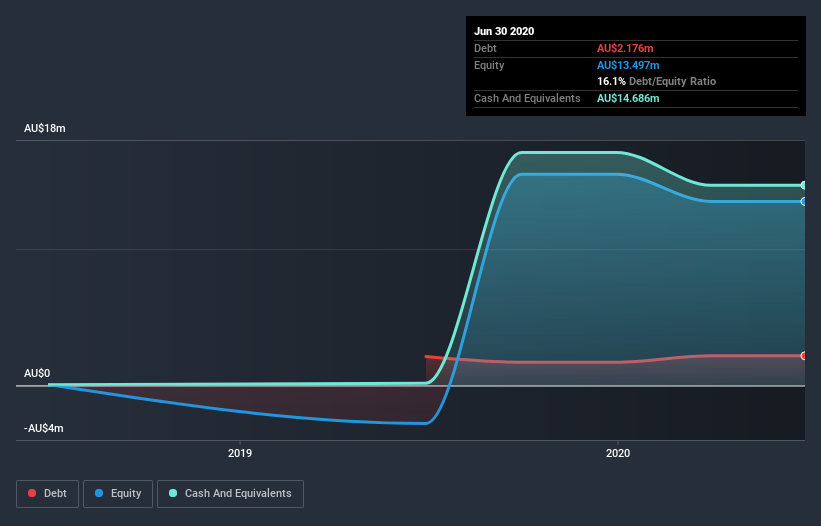Health Check: How Prudently Does Cronos Australia (ASX:CAU) Use Debt?

The external fund manager backed by Berkshire Hathaway's Charlie Munger, Li Lu, makes no bones about it when he says 'The biggest investment risk is not the volatility of prices, but whether you will suffer a permanent loss of capital.' It's only natural to consider a company's balance sheet when you examine how risky it is, since debt is often involved when a business collapses. We can see that Cronos Australia Limited (ASX:CAU) does use debt in its business. But should shareholders be worried about its use of debt?
When Is Debt Dangerous?
Generally speaking, debt only becomes a real problem when a company can't easily pay it off, either by raising capital or with its own cash flow. Part and parcel of capitalism is the process of 'creative destruction' where failed businesses are mercilessly liquidated by their bankers. However, a more usual (but still expensive) situation is where a company must dilute shareholders at a cheap share price simply to get debt under control. Of course, plenty of companies use debt to fund growth, without any negative consequences. When we examine debt levels, we first consider both cash and debt levels, together.
See our latest analysis for Cronos Australia
What Is Cronos Australia's Debt?
The chart below, which you can click on for greater detail, shows that Cronos Australia had AU$2.10m in debt in June 2020; about the same as the year before. But on the other hand it also has AU$14.7m in cash, leading to a AU$12.6m net cash position.
How Healthy Is Cronos Australia's Balance Sheet?
The latest balance sheet data shows that Cronos Australia had liabilities of AU$627.4k due within a year, and liabilities of AU$2.10m falling due after that. Offsetting this, it had AU$14.7m in cash and AU$27.2k in receivables that were due within 12 months. So it can boast AU$12.0m more liquid assets than total liabilities.
This surplus liquidity suggests that Cronos Australia's balance sheet could take a hit just as well as Homer Simpson's head can take a punch. On this view, lenders should feel as safe as the beloved of a black-belt karate master. Simply put, the fact that Cronos Australia has more cash than debt is arguably a good indication that it can manage its debt safely. The balance sheet is clearly the area to focus on when you are analysing debt. But you can't view debt in total isolation; since Cronos Australia will need earnings to service that debt. So if you're keen to discover more about its earnings, it might be worth checking out this graph of its long term earnings trend.
Given it has no significant operating revenue at the moment, shareholders will be hoping Cronos Australia can make progress and gain better traction for the business, before it runs low on cash.
So How Risky Is Cronos Australia?
By their very nature companies that are losing money are more risky than those with a long history of profitability. And the fact is that over the last twelve months Cronos Australia lost money at the earnings before interest and tax (EBIT) line. And over the same period it saw negative free cash outflow of AU$5.0m and booked a AU$3.9m accounting loss. But the saving grace is the AU$12.6m on the balance sheet. That kitty means the company can keep spending for growth for at least two years, at current rates. Even though its balance sheet seems sufficiently liquid, debt always makes us a little nervous if a company doesn't produce free cash flow regularly. The balance sheet is clearly the area to focus on when you are analysing debt. However, not all investment risk resides within the balance sheet - far from it. For instance, we've identified 4 warning signs for Cronos Australia (3 don't sit too well with us) you should be aware of.
If, after all that, you're more interested in a fast growing company with a rock-solid balance sheet, then check out our list of net cash growth stocks without delay.
This article by Simply Wall St is general in nature. It does not constitute a recommendation to buy or sell any stock, and does not take account of your objectives, or your financial situation. We aim to bring you long-term focused analysis driven by fundamental data. Note that our analysis may not factor in the latest price-sensitive company announcements or qualitative material. Simply Wall St has no position in any stocks mentioned.
Have feedback on this article? Concerned about the content? Get in touch with us directly. Alternatively, email editorial-team@simplywallst.com.

 Yahoo Finance
Yahoo Finance 
